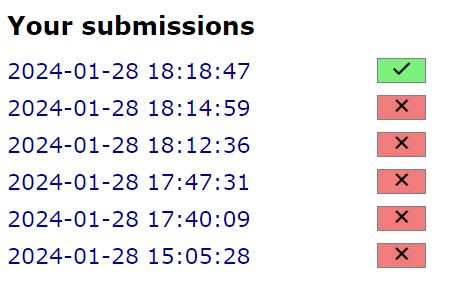CSES: Labyrinth
USACO.guide上的 easy: CSES - Labyrinth
这道确实简单,但是好久没写图论了生疏了还搞了一整子的😓.

思路
思路就是从A跑BFS到B,非常简单。所以现在就可以开始写了:
代码1
//
// Created by Chixiyu on 1/28/2024.
//
#include <bits/stdc++.h>
using namespace std;
const int N = 1010;
string graph[N];
int n, m;
bool vis[N][N];
bool valid(int x, int y) {
if (x < 0 || x >= n || y < 0 || y >= m || graph[x][y] == '#' || vis[x][y]) return false;
return true;
}
struct point {
int x;
int y;
int step;
string direction;
};
int main() {
cin >> n >> m;
pair<int, int> start;
for (int i = 0; i < n; ++i) {
cin >> graph[i];
for (int j = 0; j < m; ++j) {
if (graph[i][j] == 'A') {
start = make_pair(i, j);
}
}
}
pair<int, string> ans;
queue<point> q;
q.push({start.first, start.second, 0, ""});
bool flag = false; // "YES" or "NO"
while (!q.empty()) {
point current = q.front();
vis[current.x][current.y] = true;
q.pop();
if (graph[current.x][current.y] == 'B') {
cout << "YES" << endl << current.step << endl << current.direction;
flag = true;
break;
}
current.direction.push_back('D');
if (valid(current.x + 1, current.y)) {
q.push({current.x + 1, current.y, current.step + 1, current.direction});
vis[current.x + 1][current.y] = true;
}
current.direction.pop_back();
current.direction.push_back('U');
if (valid(current.x - 1, current.y)) {
q.push({current.x - 1, current.y, current.step + 1, current.direction});
vis[current.x - 1][current.y] = true;
}
current.direction.pop_back();
current.direction.push_back('L');
if (valid(current.x, current.y - 1)) {
q.push({current.x, current.y - 1, current.step + 1, current.direction});
vis[current.x][current.y - 1] = true;
}
current.direction.pop_back();
current.direction.push_back('R');
if (valid(current.x, current.y + 1)) {
q.push({current.x, current.y + 1, current.step + 1, current.direction});
vis[current.x][current.y + 1] = true;
}
}
// output
if (!flag) { cout << "NO" << endl; }
return 0;
}
但是这样子会发现有一个点超时了,???
可能是BFS过程中每一步都保存了完整的点,我们可以只保存上次的那个 point的地址,使用指针在找到 B之后,直接用指针链回去反推出完整路径(记得翻转)。
代码2
成功AC
//
// Created by Chixiyu on 1/29/2024.
//
#include <bits/stdc++.h>
using namespace std;
const int N = 1010;
char graph[N][N]; // Using a character array is more space-efficient than std::string
bool vis[N][N];
int n, m;
int dx[] = {1, -1, 0, 0}; // Directions: down, up, right, left
int dy[] = {0, 0, 1, -1};
char dir[] = {'D', 'U', 'R', 'L'}; // Corresponding characters for directions
struct point {
int x, y, step;
point* prev; // Pointer to previous point for path reconstruction
char move; // Move taken to get to this point
};
bool valid(int x, int y) {
return x >= 0 && x < n && y >= 0 && y < m && graph[x][y] != '#' && !vis[x][y];
}
string reconstruct_path(point* p) {
string path;
while (p->prev) {
path.push_back(p->move);
p = p->prev;
}
reverse(path.begin(), path.end());
return path;
}
int main() {
ios_base::sync_with_stdio(false);
cin.tie(nullptr);
cin >> n >> m;
pair<int, int> start, end;
for (int i = 0; i < n; ++i) {
for (int j = 0; j < m; ++j) {
cin >> graph[i][j];
if (graph[i][j] == 'A') {
start = {i, j};
} else if (graph[i][j] == 'B') {
end = {i, j};
}
}
}
queue<point> q;
q.push({start.first, start.second, 0, nullptr, 0});
vis[start.first][start.second] = true;
bool found = false;
while (!q.empty()) {
point current = q.front();
q.pop();
if (current.x == end.first && current.y == end.second) {
cout << "YES\n" << current.step << "\n" << reconstruct_path(¤t);
found = true;
break;
}
for (int i = 0; i < 4; ++i) {
int nx = current.x + dx[i], ny = current.y + dy[i];
if (valid(nx, ny)) {
vis[nx][ny] = true;
q.push({nx, ny, current.step + 1, new point(current), dir[i]});
}
}
}
if (!found) {
cout << "NO\n";
}
return 0;
}
